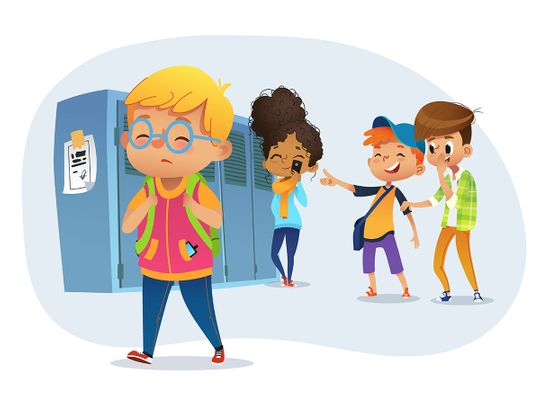
“My son wears glasses,” says Pakistani expat Ana Khan. “When he was four-and-a-half-years-old, his father, who had dropped him off at school, was cleaning his glasses when another child walked up to them. The kid said, ‘You can’t see right?’ and my son, Azaan, said he could. Next thing you know, there was a loud thud; the child had slapped him. He then said, ‘Bet you didn’t see that coming’.”
When the Khans reported this behaviour, the school told them that it’s only if the behaviour is repeated over time by the same child that it would be considered bullying. Years on, Khan is still furious. She adds, in an interview with Gulf News, “Different kids would target him and nothing would be done.” Finally, two years later, they decided to move him out of the school. “We went through a lot as a family to get him out of it. We had to get him to do self-defence lessons, self-confidence lessons.” It was traumatic.

As a student, when you go to school and you get messages that you are not worthy – then it’s what you start to believe about yourself.
The whole problem of bullying is that it gnaws at a person’s self-confidence, whittling it away until all that’s left is distress. “As a student, when you go to school and you get messages that you are not worthy – then it’s what you start to believe about yourself,” explains Dr Haneen Jarrar at the launch of Cartoon Network and United Nations Children's Fund’s nationwide anti-bullying campaign, ‘Be a buddy not a bully’.
The consequences of such exposure can be dire – and can lead not only to low self-confidence but also in extreme cases, to suicidal ideation.
The known instances of bullying have increased over the years explains Jarrar, because of a number of factors.
- Increase in population
- Shift in values: If it’s the norm that when you are in a flight or fight situation it’s the strongest who takes the most, there are going to be many instances of bullying.
- Media: Bullying has also become normalised in a lot of the videos and the series that the kids are watching - it’s being popularised. “Children are spending so much time on these social media platforms and watching these rather than playing outside with friends, they are mimicking the aggression.”
To stop it, we must first define it. Australia-based National Center Against Bullying defines bullying as “…an ongoing and deliberate misuse of power in relationships through repeated verbal, physical and/or social behaviour that intends to cause physical, social and/or psychological harm. It can involve an individual or a group misusing their power, or perceived power, over one or more persons who feel unable to stop it from happening.”
Simon Crane, Head Master at Brighton College Dubai, explains it as “persistent unkindness over time”.
There are essentially four bands of bullying behaviour:
- Physical: hitting, tripping, hair pulling, stealing, pushing, breaking someone’s things, hitting, scratching, pinching
- Socially: telling other kids not to be friends with someone, excluding others, spreading rumours
- Verbal: threats, insults, hurtful comments, name-calling, teasing
- Cyber bullying

A 2021 survey by Cartoon network and YouGov, conducted in February that saw 2,015 parents across the UAE and Saudi Arabia weigh in, found that two out of five parents has seen an increase in cyber bullying during the pandemic. Other findings of the study: 35 per cent think that verbal bullying is the most common form of bullying that’s happening and 40 per cent of parents have seen an increase in cyber bullying during the pandemic. According to the study, the majority of the cases have been thought to have not been reported to local authority and in the cases it has been reported, it was done mainly by the parent.
Are some kids more likely to be perpetrators? Or victims?
Jarrar says there are some common traits seen in bullies. These are:
- kids who are more likely to be aggressive,
- kids who are more likely to be impulsive,
- those who see aggression as normal or not something to worry about,
- those who blame others for their own mistakes or tend to be too hyper active.
When it comes to the victim, Jarrar is emphatic: “It’s never the victim’s fault, it’s always the bully’s fault.”
Red flag
Watch out for the following warning signs that indicate your child is being bullied.
- Unexplained marks
- Drop In attendance or grades
- Refusing to go to school
- Change In eating habits
- Health complaints
- Withdrawals
The best way forward, says Jarrar, when it comes to combatting bullying is to educate - everyone. It’s turning the bystander effect on its head. “Teach them to say – and think – bullying is not acceptable in our home, school, community.” It is important to get those who are passively watching to help.
The common complaint a parent of an aggressive child has, mulls Jarrar, is that the kid was only defending himself and how could they ask the child not to retaliate? She explains that this puts the onus of a situation squarely on the shoulders of a young person ill-equipped to deal with it. It must be the responsibility of the parents, the schools and the wider community to nip the ordeal in the bud.
How to talk to kids about bullying
1. Prevention is best: Talk to kids about what is acceptable and what is not. Tell them, says Jarrar, “You are very important as a person, we don’t speak to you like this in our family so don’t allow anyone else to speak to you like this. If you as a parent read to them a story on social bullying, they know if it happens to them. And they stop and they say, stop what you are doing is not very nice.”
2. If reported, take the charge seriously. “It’s so important not to minimise the issue – empathise, connect and say, ‘… that must feel so bad for you – I will try my best to make it stop.’ And then you bring it to the attention of the school and you make sure you keep at it till it stops, because it’s not a minor issue. It can really have a major effect on the children,” she adds.
In the case of Azaan, this intervention took time. The shadow of those brutal days – “once he came home with a bite mark” – can still be seen following him sometimes, says Khan.
Have a topic you'd like us to cover? Write to us at parenting@gulfnews.com








